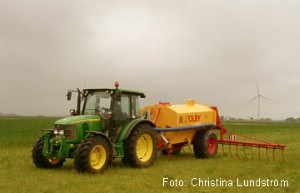Project manager: Sofia Delin, Department of Soil and Environments, SLU
This project aims to study the course of nitrogen mineralization under natural temperature conditions after fertilization at different times of the year. This is done through incubation of organic fertilizers mixed with soil in plastic bottles. The ammonium and nitrate nitrogen are hereby kept within the system being studied and the changes with time can be calculated.
The bottles are placed in the topsoil at different times of the year, simulating times of fertilization. They are aerated through a pipe emerging at the soil surface. The soil temperature is measured continuously with time. The fertilizers being studied in this project are:
- meat and bone meal,
- dairy slurry,
- dairy farmyard manure,
- broiler manure and
- a by-product from yeast production.
On all occasions when bottles are placed in the field, a treatment with only soil is added to determine how much the soil organic material contributes to the mineralization. The soil in the bottles is a sandy soil and the bottles (3 replicates) are placed in a field in south-west Sweden (Västergötland) at 2-4 different times of fertilization depending on the type of fertilizer being tested. These different times of fertilization are autumn, early spring, spring (at sowing) and early summer.
Bottles are taken up for analysis of NH4-N and NO3-N on 3-7 occasions depending on time of fertilization. In this way, the contents of ammonium and nitrate are used to describe the course of mineralization from the time of fertilization until late autumn after the end of the growing season.
